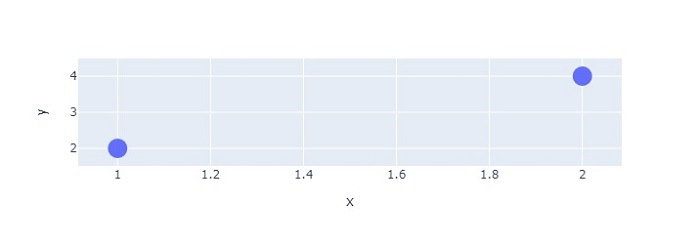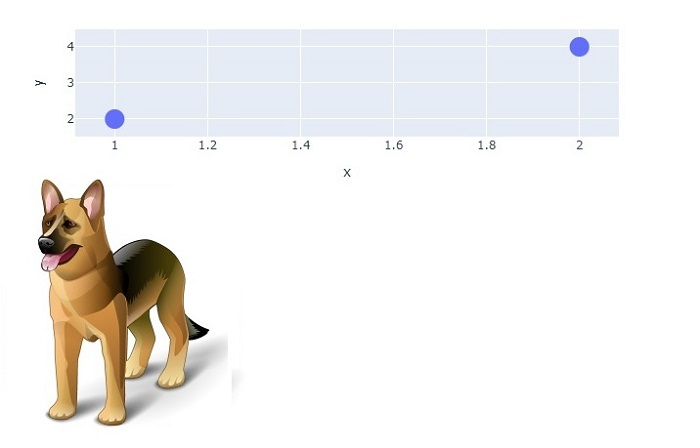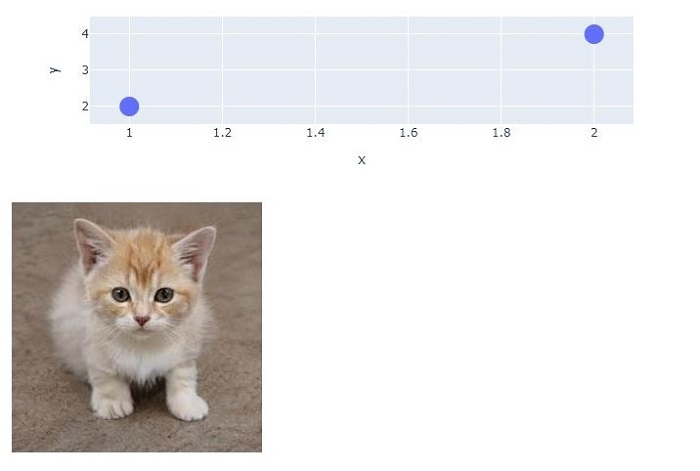
 Data Structure
Data Structure Networking
Networking RDBMS
RDBMS Operating System
Operating System Java
Java MS Excel
MS Excel iOS
iOS HTML
HTML CSS
CSS Android
Android Python
Python C Programming
C Programming C++
C++ C#
C# MongoDB
MongoDB MySQL
MySQL Javascript
Javascript PHP
PHP
- Selected Reading
- UPSC IAS Exams Notes
- Developer's Best Practices
- Questions and Answers
- Effective Resume Writing
- HR Interview Questions
- Computer Glossary
- Who is Who
How to display an image on hovering over a point in Python Plotly?
Plotly is an open-source plotting library in Python that can generate several different types of charts. Python users can use Plotly to create interactive web-based visualizations that can be displayed in Jupyter notebooks, saved to standalone HTML files, or served as a part of web applications using Dash. Plotly can also be used in static document publishing and desktop editors such as PyCharm and Spyder.
Dash is a Python framework and it is used to create interactive web-based dashboard applications. The dash library adds all the required libraries to web-based dashboard applications.
In this tutorial, we will show how you can add multiple graphs to a Plotly Dash app on a single browser page.
Follow the steps given below to generate Dash app on a single page.
Step 1
Import the Dash library.
import dash
Step 2
Import the Dash core components, dcc and html. We will use the dcc.Graph() method to set the style for height and width coordinates.
from dash import dcc, html
Step 3
Import the dash dependencies using the below module.
from dash.dependencies import Input, Output
Step 4
Import the plotly.express module and alias as px. We will use this method to generate graphs.
import plotly.express as px
Step 5
Generate a dataset using the Pandas module.
#generate dataframe
df = pd.DataFrame(
dict(
x=[1, 2],
y=[2, 4],
images=[dogImage,catImage],
)
)
Step 6
Set the images from specific URLs. The sample URL is defined below ?
dogImage = "data:image/png;base64, catImage = "data:image/png;base64,
Step 7
Create a scatter plot with the X and Y coordinates ?
# create scatter plot with x and y coordinates fig = px.scatter(df, x="x", y="y",custom_data=["images"])
Step 8
Create the main function to run the App server using the following command ?
app = dash.Dash(__name__) if __name__ == '__main__': app.run_server(debug=True)
Step 9
Use the update_layout() method to perform click mode and set the update_traces() method to perform marker size.
# Update layout and update traces fig.update_layout(clickmode='event+select') fig.update_traces(marker_size=20)
Step 10
Generate the App layout to show the Dash graph. It is defined below,
# Create app layout to show dash graph
app.layout = html.Div(
[
dcc.Graph(
id="graph_interaction",
figure=fig,
),
html.Img(id='image', src='')
]
)
Step 11
Create the callback() function to hover the data on specific coordinates, as shown below ?
@app.callback(
Output('image', 'src'),
Input('graph_interaction', 'hoverData'))
def open_url(hoverData):
if hoverData:
return hoverData["points"][0]["customdata"][0]
else:
raise PreventUpdate
# Create app layout to show dash graph
app.layout = html.Div(
[
dcc.Graph(
id="graph_interaction",
figure=fig,
),
html.Img(id='image', src='')
]
)
Example
The complete code to display an image on hovering dash graph,
import dash from dash.exceptions import PreventUpdate from dash import dcc, html from dash.dependencies import Input, Output import plotly.express as px import pandas as pd # Create dash app app = dash.Dash(__name__) # Set dog and cat images dogImage = "https://www.iconexperience.com/_img/v_collection_png/256x256/shadow/dog.png" catImage = "https://d2ph5fj80uercy.cloudfront.net/06/cat3602.jpg" # Generate dataframe df = pd.DataFrame( dict( x=[1, 2], y=[2, 4], images=[dogImage,catImage], ) ) # Create scatter plot with x and y coordinates fig = px.scatter(df, x="x", y="y",custom_data=["images"]) # Update layout and update traces fig.update_layout(clickmode='event+select') fig.update_traces(marker_size=20) # Create app layout to show dash graph app.layout = html.Div( [ dcc.Graph( id="graph_interaction", figure=fig, ), html.Img(id='image', src='') ] ) # html callback function to hover the data on specific coordinates @app.callback( Output('image', 'src'), Input('graph_interaction', 'hoverData')) def open_url(hoverData): if hoverData: return hoverData["points"][0]["customdata"][0] else: raise PreventUpdate if __name__ == '__main__': app.run_server(debug=True)
Output
It will show the following output on the Console.
Dash is running on http://127.0.0.1:8050/ * Serving Flask app 'main' * Debug mode: on
Click the URL and it will display the output on the browser ?

Now, hover the mouse over the coordinates (1,2) and you will get to the see the following output ?

Similarly, when you hover the mouse over the second point, it will produce the following output ?


